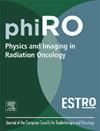Image-based mandibular and maxillary parcellation and annotation using computed tomography (IMPACT): a deep learning-based clinical tool for orodental dose estimation and osteoradionecrosis assessment
IF 3.3
Q2 ONCOLOGY
引用次数: 0
Abstract
Background and purpose
Accurate delineation of orodental structures on radiotherapy computed tomography (CT) images is essential for dosimetric assessment and dental decisions. We propose a deep-learning (DL) auto-segmentation framework for individual teeth and mandible/maxilla sub-volumes aligned with the ClinRad osteoradionecrosis staging system.
Materials and methods
Mandible and maxilla sub-volumes were manually defined on simulation CT images from 60 clinical cases, differentiating alveolar from basal regions; teeth were labelled individually. For each task, a DL segmentation model was independently trained. A Swin UNETR-based model was used for mandible sub-volumes. For smaller structures (e.g., teeth and maxilla sub-volumes) a two-stage model first used the ResUNet to segment the entire teeth and maxilla regions as a single ROI used to crop the image input for Swin UNETR. In addition to segmentation accuracy and geometric precision, a dose-volume comparison was made between manual and model-predicted segmentations.
Results
Segmentation performance varied across sub-volumes – mean Dice values of 0.85 (mandible basal), 0.82 (mandible alveolar), 0.78 (maxilla alveolar), 0.80 (upper central teeth), 0.69 (upper premolars), 0.76 (upper molars), 0.76 (lower central teeth), 0.70 (lower premolars), 0.71 (lower molars) – with limited applicability in segmenting sub-volumes absent in the data. The maxilla alveolar central sub-volume showed a statistically significant dose-volume difference in both Dmean and D2%.
Conclusions
We present a novel DL-based auto-segmentation framework of orodental structures, enabling spatial localization of dose-related differences. This tool may enhance image-based bone injury detection and improve clinical decision-making in radiation oncology and dental care for head and neck cancer patients.
使用计算机断层扫描(IMPACT)进行基于图像的下颌和上颌的分割和注释:一种基于深度学习的临床工具,用于牙齿剂量估计和骨放射性坏死评估
背景和目的在放射治疗计算机断层扫描(CT)图像上准确描绘口腔结构对剂量学评估和牙科决策至关重要。我们提出了一个深度学习(DL)自动分割框架,用于与ClinRad骨放射性坏死分期系统对齐的单个牙齿和下颌骨亚体积。材料和方法对60例临床病例的模拟CT图像进行人工定义下颌骨和上颌骨亚体积,区分牙槽区和基底区;牙齿分别贴上标签。对于每个任务,都独立训练了一个DL分割模型。下颌骨亚体积采用基于Swin unet的模型。对于较小的结构(例如,牙齿和上颌骨子体积),两阶段模型首先使用ResUNet分割整个牙齿和上颌骨区域作为单个ROI,用于裁剪Swin UNETR的图像输入。除了分割精度和几何精度外,还对人工分割和模型预测分割进行了剂量-体积比较。结果不同亚体积的分割效果不同,Dice平均值分别为0.85(下颌骨基牙)、0.82(下颌骨牙槽牙)、0.78(上颌牙槽牙)、0.80(上中牙)、0.69(上前磨牙)、0.76(上磨牙)、0.76(下中牙)、0.70(下前磨牙)、0.71(下磨牙),在数据缺失的亚体积分割中适用性有限。上颌骨牙槽中心亚容积在Dmean和D2%上均有统计学意义。结论提出了一种新的基于dl的口腔结构自动分割框架,实现了剂量相关差异的空间定位。该工具可以增强基于图像的骨损伤检测,并改善头颈癌患者放射肿瘤学和牙科护理的临床决策。
本文章由计算机程序翻译,如有差异,请以英文原文为准。
求助全文
约1分钟内获得全文
求助全文
来源期刊

Physics and Imaging in Radiation Oncology
Physics and Astronomy-Radiation
CiteScore
5.30
自引率
18.90%
发文量
93
审稿时长
6 weeks
 求助内容:
求助内容: 应助结果提醒方式:
应助结果提醒方式:


